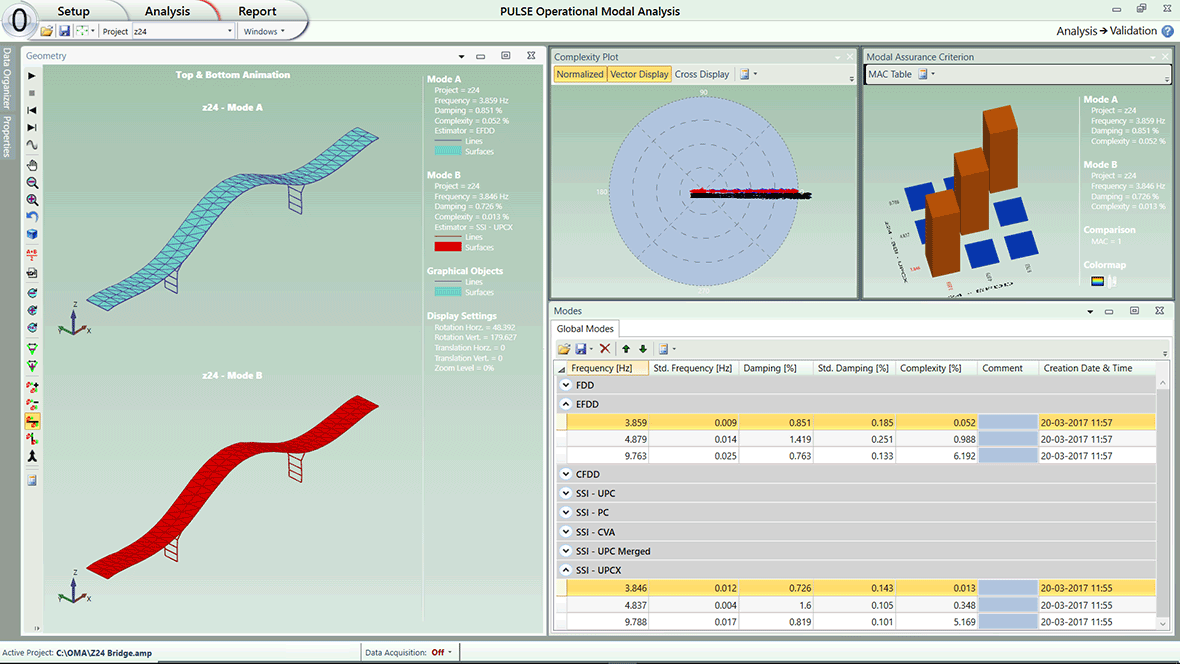PULSE TYPE 8760 + 8762
Operational Modal Analysis (OMA) Software
Operational modal analysis software for post-measurement modal analysis of structures under operating conditions without artificially exciting the structure.
Richiedi un preventivoPULSE Operational Modal Analysis performs modal analysis by only using the measured time data output of a structure. Because there is no need to measure the input forces, it is ideal for testing under actual operating conditions, and in situations where it is difficult or impossible to control an artificial excitation of the structure. This makes the setup and measurement procedure simple and fast, as only accelerometers are used – with no hammer or shaker excitation. Downtime is further reduced with in situ testing, during normal operation.
USE SCENARIOS
- Testing civil engineering structures that are loaded by uncontrollable and unmeasurable ambient forces, such as waves on offshore structures, wind load on buildings, and traffic load effects on bridges
- Capturing real-life modal parameters of mechanical structures such as aircraft during flight, full vehicles on test tracks, running trains and operating machinery during actual operating conditions
- Testing of large mechanical structures that are difficult to excite artificially, such as ships and submarines
- Estimation of modal parameters to be used for finite element (FE) model correlation and model updating, or for design verification, benchmarking, troubleshooting and quality control
CAPABILITIES
This operational modal analysis (OMA) software contains powerful algorithms for accurate modal identification and is yet very easy to use with its task-oriented user interface, intuitive workflow and high degree of automation, including automatic mode estimation. The software is available in Basic, Standard and Pro versions.
- Determining the modal parameters (natural frequencies, damping ratios and mode shapes) of structures in operation
- Estimation of uncertainties of extracted natural frequencies, damping ratios and mode shape complexities (Pro only)
- Modal parameter identification using actual boundary conditions, actual spatial and frequency distributions of forces and actual force and response levels
- Automatic identification and suppression of deterministic signals (harmonic components)
- Powerful time domain (Pro only) and frequency domain algorithms
- Crystal clear stabilization diagrams to discriminate between physical modes and computational modes (Pro only)
- Modal assurance criterion (MAC) plots and tables
- Complexity plots and mode normalization
- Time and frequency domain ODS analysis
- Fast stochastic subspace identification (SSI) analysis of large amounts of data files without user interaction (batch processing mode; Pro only)
- Export of animations using AVI movie files
- Reporting in Microsoft® Word and Microsoft Excel®
- Structural Health Monitoring (SHM) options (Pro only)
The core technology behind the operational modal analysis software is protected by patents. This includes the efficient and powerful frequency domain decomposition (FDD), enhanced frequency domain decomposition (EFDD) and curve-fit frequency domain decomposition (CFDD) algorithms. In addition, there are four unbiased time domain SSI techniques: principal components (PC), unweighted principal components (UPC), extended unweighted principal components (UPCX) and canonical variate analysis (CVA).
ADDITIONAL CAPABILITIES
- Structural Health Monitoring (SHM) options are available for PULSE OMA Pro.








